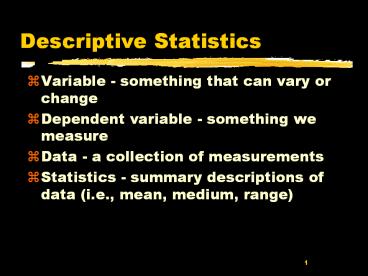Descriptive Statistics - PowerPoint PPT Presentation
1 / 15
Title:
Descriptive Statistics
Description:
Descriptive Statistics Variable - something that can vary or change Dependent variable - something we measure Data - a collection of measurements – PowerPoint PPT presentation
Number of Views:307
Avg rating:3.0/5.0
Title: Descriptive Statistics
1
Descriptive Statistics
- Variable - something that can vary or change
- Dependent variable - something we measure
- Data - a collection of measurements
- Statistics - summary descriptions of data (i.e.,
mean, medium, range)
2
Descriptive Statistics
- Used to describe or summarize sets of data to
make them more understandable - measures of central tendency
- mean, median, mode
- measures of variability
- range, standard deviation
- measures of association
- correlation coefficient
3
Measures of Central Tendency
- What is the average family income above?
- Mean - the arithmetic average
- Median - the center score
- Mode - the score that occurs the most
4
Measures of Variability
- Range - the difference between the highest and
lowest score in a set of data - Standard deviation - reflects the average
distance between every score and the mean
5
Correlation Coefficient
- Often we measure more than one variable
- Grade point and SAT score
- Are they related?
- Correlation statistic is a way to find out
6
Correlation Coefficient
- Measures whether two variables change in a
related way - Can be positive (max 1.00)
- Negative (min -1.00)
- Or not related! ( 0.0)
7
Inferential Statistics
- Descriptive statistics summarize a data set
- We often want to go beyond the data
- Is the world at large like my sample?
- Are my descriptive statistics misleading?
- Inferential statistics give probability that the
sample is like the world at large
8
Statistics and Probability
- Probability means how likely something is
- How likely are results like mine to occur by
chance? - Statistical inferences
- significant result - reflects the real world
rather than chance, with high probability (e.g.,
gt .95 ) - not significant - results reflect chance
9
Measurement Errors
- Why is inference based on probability instead of
certainty? - Data can be misleading because of variability
- low variability
- high variability
10
Measurement Errors
- Why is inference based on probability instead of
certainty?
- Data can be misleading because of bias
- low bias
- high bias
11
Measurement Error
- Variability and bias can combine
12
Sources of Bias
- Biased sample - when the members of a sample
differ in a systematic way from the larger
population the researcher is interested in - Example
- interested in all voters
- contact by telephone
- biased sample - lower economic groups may not own
telephones
13
Sources of Bias
- Observer-expectancy effect
- researcher has expectations that influence
measurements - Subject-expectancy effect
- subject knows design and tries to produce
expected result - Blinding
- minimize expectancy by removing knowledge about
experimental conditions
14
Blinding
- Single-blind study - when subjects are kept
uninformed as to the treatment they are receiving - Double-blind study - when both subjects and
experimenter are kept uninformed about aspects of
the study that could lead to differential
expectations
15
Ethical Issues in Psychological Research
- Right to privacy
- Informed consent
- use of deception
- Animal rights
- Is there justification for discomfort or harm a
research procedure may produce? - APA publishes ethical guidelines































